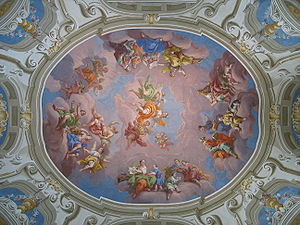 Global Information
Global InformationHistory of Latin information
This article needs additional citations for verification. (October 2011) |


Latin is a member of the broad family of Italic languages. Its alphabet, the Latin alphabet, emerged from the Old Italic alphabets, which in turn were derived from the Etruscan, Greek and Phoenician scripts. Historical Latin came from the prehistoric language of the Latium region, specifically around the River Tiber, where Roman civilization first developed. How and when Latin came to be spoken has long been debated.
Various influences on Latin of Celtic dialects in northern Italy, the non-Indo-European Etruscan language in Central Italy, and the Greek in some Greek colonies of southern Italy have been detected, but when these influences entered the native Latin is not known for certain.
Surviving Roman-era Latin literature consists almost entirely of Classical Latin pieces usually chosen for their importance as help for people learning to write in Latin. Survivals emphasise polished and sometimes highly stylized literary language texts sometimes termed Golden Latin, which spans the 1st century BC and the early years of the 1st century AD.
As with any written language, the spoken language differed somewhat in grammar, tone and vocabulary, and is referred to as Vulgar Latin. However, theories that the spoken and written languages were more or less different, separated by class or elite education, are now generally rejected.[1]
In addition to Latin, the Greek language was often spoken by the well-educated elite, who studied it in school and acquired Greek tutors from among the influx of enslaved educated Greek prisoners of war, captured during the Roman conquest of Greece. In the eastern half of the Roman Empire, later referred to as the Byzantine Empire, the Greek Koine of Hellenism remained current among peasants and traders, while Latin was used for laws and administrative writings. It continued to influence the Vulgar Latin that would evolve into the Eastern Romance languages.
Latin had a long working life beyond the Roman period, as it was the language of the Roman Catholic Church, and later of the Carolingian Holy Roman Empire. It was the dominant language of European learning, literature and academia through the middle ages, and in the early modern period. Latin's relevance as a widely used working language ended around 1800, although examples of its productive use extend well into that century, and in the cases of the Catholic Church and Classical studies, continue to the present day. As a result, the vast majority - over 99.99% of extant Latin texts - belong to these later periods, and especially to the Neo-Latin period.[2]
- ^ Herman 2000, p. 5 "Comparative scholars, especially in the nineteenth century … tended to see Vulgar Latin and literary Latin as two very different kinds of language, or even two different languages altogether … but [this] is now out of date"
- ^ Leonhardt 2009, p. 2